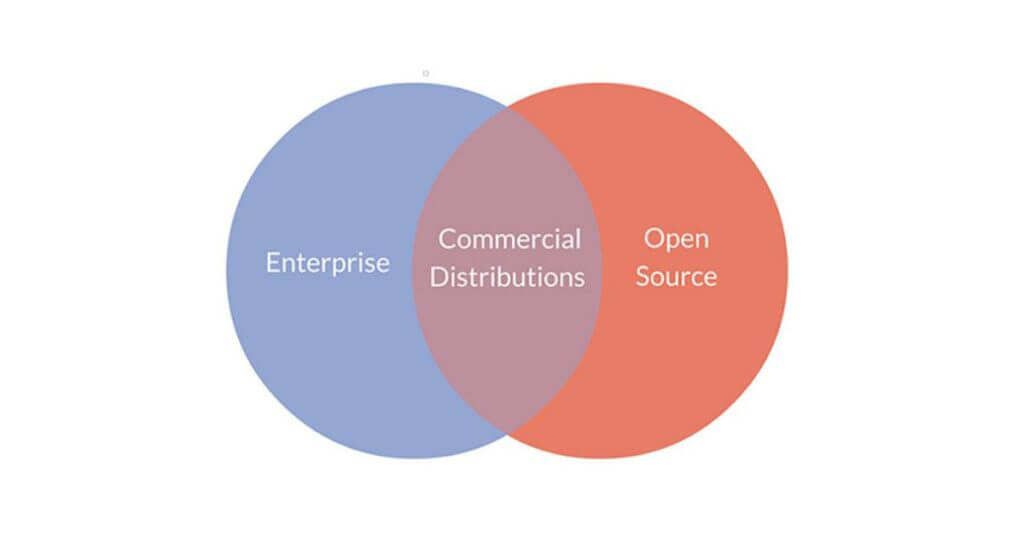I recently did a webinar with Jay Lyman, Research Manager at 451 Research, discussing the trends in open source programming language adoption by enterprises and how they impact the overall business. It’s been fantastic to see that the adoption of open source technologies by larger companies has continued to accelerate in recent years. Open source has been around for a while, but why are enterprises using open source more today than before?
Why Do Enterprises Want Open Source?
Why do enterprises want open source? In the webinar, Jay touched on a number of different perspectives, but I wanted to drill down a little bit more on some specific reasons why enterprises choose open source.
- It’s really easy to acquire. There’s no lengthy procurement process and, in this sense, it’s very easy for Shadow IT to use open source software. You can easily bring it into your organization, experiment, and do things with it. (While it’s easy to get, organizations typically don’t want to bring open source into their mission critical or business critical applications unless they follow proper procedures within the enterprise. But, it’s easy to acquire.)
- Own your own code. The second reason for open source in the enterprise is that you can own your own code. The beauty of open source is that you can take this code, change it, add functionality, customize it and now you own any of the changes or the derivatives.
- The software quality is always improving. You’re making improvements to the software code, the community’s making improvements, so you have this wave effect working in the community. The code is always getting better; it doesn’t get stale. And with that, you get code stability because you have a global community of developers often working on the codebase.
- Draw from the open source community for help. When you run into issues or challenges or specific things related to the code, you can reach out to the community.
That being said, given all the benefits open source, why even consider a commercial distribution or a commercial vendor for your open source technologies?
The Importance of Commercial Distributions
Open source is great, but there are still some enterprises hesitant to implement it. Below are some of reasons why companies would (and maybe should) consider a commercial distribution instead of directly using the open source technology:
- Get quality assured builds. You get quality assured builds tested and proven for the enterprise. There is a lot of passion by the developers who are working on a particular open source project. But those who are working on the project are not interested in specific issues related to an enterprise and their needs. And that’s where commercial vendors often provide that added value to make open source really work for the enterprise. Commercial distributions are quality assured, tested and proven.
- SLAs. The next reason for considering commercial distributions is the Service Level Agreements (SLAs) you get with them. While you can go to the open source community to get support, often if you’re running a mission-critical application, you may need support in 2 hours, 4 hours or within 24 hours. You may not get that with the open source community and that’s a reason why you would partner with a commercial distribution.
- Pre-compiled, ready-to-go. The next reason, and I think it’s really important, is that a commercial distribution is pre-compiled, easy-to-use, ready-to-go, out-of-the-box one-click solution. Often with open source you can find repositories, but there are many branches of different information to digest and include for your project. It’s not easy to consume, and often enterprises need a really easy way to consume the open source. That’s what a commercial distribution does. Support and maintenance of older versions.
- Support and maintenance of older language versions–specifically Perl, Python, and Tcl–is how we’ve been helping customers significantly as open source languages evolve. Often, enterprises don’t want to use the latest and greatest language–maybe all of their other machines are using an old version, so adding a new version will just complicate things. They are maybe one, two, or three (or more) versions behind because they need to standardize. They don’t want to be updating to the latest and greatest as quickly as the community does. And so, a commercial distro will provide that support on the older versions. For example, when the HeartBleed bug hit, a number of enterprises were on an older version of ActivePerl, ActiveTcl and ActivePython. We were immediately able to deal with that very rapidly, in less than 24 hours, providing “peace of mind. The open source Perl, Python, and Tcl communities also resolved the issue, but in a longer time frame. Finally, large corporations have multitudes of servers and they want to standardize on a single distro that works across the various platforms they’re working with; another reason to want and older version of the distribution.
- Compliance. And often another reason to choose a commercial distribution is because many enterprises have a compliance requirement–if they use open source in the enterprise, they must have a third party commercial vendor providing support. Finance, health care, government…many of these industries have mandated rules around this. They can’t have open source working on mission critical applications or business critical applications without third party support.
- Indemnification. Another very popular reason for using a commercial distribution is indemnification; getting that coverage for trademark and IP infringement. A commercial vendor could stand behind that and protect your organization.
- OEM (original equipment manufacturer) rights. If a company is looking to distribute a product that includes an open source language, getting the rights to redistribute a commercially supported version of that language can give you tremendous peace of mind. Embedding a commercial language distribution in their products can help them to get to market faster, and provide risk-free reliability their customers demand. Ignoring open source licensing terms can be dangerous. It can cost you in IP infringement lawsuits, hefty lawyers’ bills and a damaged reputation. Partnering with a commercial vendor helps them get turn-key redistribution licenses and eliminate legal risks.
Commercial distributions have a very real place in the open source landscape. At ActiveState we make open source work for the enterprise–we’ve been leveraging open source and building products with the enterprise in mind since 1997. But in addition to making it work for our customers, we also believe it’s important to support the community by contributing back to it and ensuring that the quality of these projects are maintained.
ActiveState provides commercial distributions for Perl, Python and Tcl. If you have any questions about our enterprise and OEM solutions, please contact us.






